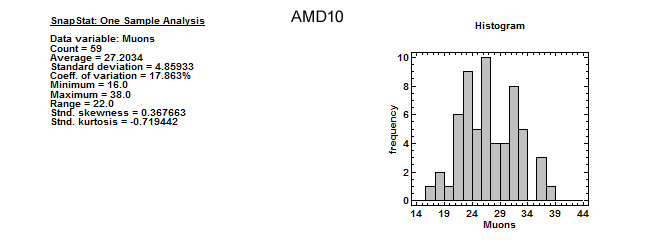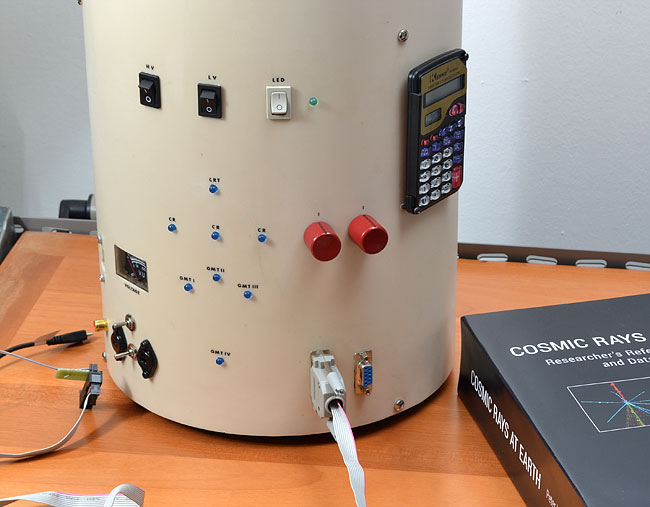Introduction
AMD10 is a cosmic rays detector, it works with 4 Geiger-Müller tubes, type Si22G (160 x Ø18 mm usefull surface).
This detector was ideated to get an high rate of measurement in comparison to detectors with one single channel, moreover the three channels have different geometry thus they "see" incoming cosmic rays from different directions.
Description
As for every cosmic ray detector, is considered as single cosmic ray (muon) only a particle that cross at least two counters aligned along an axis, this because muons are very energetic particles and can travel through many meters of material (hundreds) without lose energy in a perceptible way.
From the schematic below, you can see that every single channel is formed from a couple of GMT (1-4, 2-4, 3-4). The second channel, the central one, (GMT 2-4) points to the Zenith, instead the right and left channels are inclined by 10°, nevertheless the geometry lets every channel to frame a (plain) angle equal to 10°, so the instrument as a whole has 30° of field of view.
Aims:
AMD10 at first was conceived with the aim to do measurements about cosmic ray absorption in materials and intensity loss in rocks or to hazard measurement about muon tomography - always in educational purview - furthermore, contemporary measurement on three channels permits a quick clue on many aspects: the dependence from the zenital angle, the latitude effect and the the east-west effect; this detector will also be employed as support on the ADA project, a network of cosmic ray detectors in Italy and Switzerland.
Technics:
The detector has several settings, according on the measurement type, you can select a channel one by one or get the data from all the channels, thus the total muons crossing the detector. Having three channels complicate a bit the data acquisition procedure, so a new version of the AstroRad software is incoming to get data from all the channels at the same time. AMD10 however has several outputs to connect other devices such as microprocessors, data-logger and so on.

AMD10 connected to a tablet pc
AMD10 videoclip
First data
Results from a very first test, with a "standard" setting give us a mean rate of 27 cpm (muons per minute) considering all the channels together, a good rate for our expected aims.

Statistics of the first test
In the next months will follow practical applications with the use of this new cosmic ray detector.

AMD10 -in the foreground connections to computers and other peripherals

Some phases of the construction

Un Pulsar… Ma Che Ne Appaiono Tre? 13.12.2025
Un miraggio nei Cieli Gamma. Astronomi e astrofisici si sono posti una domanda intrigante: perché alcune mappe del cielo gamma mostrano più sorgenti luminose vicino a un pulsar, anche se non ci sono stelle reali in quei punti? Secondo un nuovo studio, la risposta potrebbe essere un’illusione ottica cosmica. I raggi cosmici, sotto forma di elettroni ultra-energetici lanciati da un pulsar, viaggiano lungo i campi magnetici turbolenti della Via Lattea. Quando questi campi sono allineati con la nostra linea di vista, possono proiettare emissioni gamma in più punti del cielo, creando quello che gli scienziati chiamano “mirage halos”: aloni luminosi che sembrano sorgere lontano dalla vera fonte. In altre parole, un singolo pulsar può apparire come tre diversi oggetti gamma solo grazie alla geometria dei campi magnetici e all’effetto di proiezione. Simulazioni dettagliate mostrano come gli elettroni traccino percorsi filamentosi dando origine a bracci e punti luminosi che ingannano gli osservatori. Per distinguere questi miraggi dalle vere sorgenti, gli astronomi confronteranno i dati gamma con osservazioni a raggi X, che rispondono in modo diverso alla direzione del campo magnetico. Questo lavoro ci ricorda che la struttura magnetica della Galassia può modellare ciò che vediamo nel cielo ad alte energie — e che ciò che sembra “molto” in realtà potrebbe essere solo un trucco prospettico...

Fonte: Astrobites
Il libro AstroParticelle
26.09.2013 - Un viaggio scientifico tra i raggi cosmici raccontato attraverso la storia, le invenzioni i rivelatori e gli osservatori; senza trascurare gli effetti che essi producono coinvolgendo numerose discipline scientifiche tra cui astrofisica, geofisica e paleontologia.
Accedi | Registrati